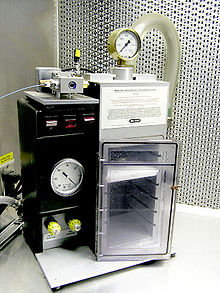Gene gun
In genetic engineering, a gene gun or biolistic particle delivery system is a device used to deliver exogenous DNA (transgenes), RNA, or protein to cells.The original target was onions (chosen for their large cell size), and the device was used to deliver particles coated with a marker gene which would relay a signal if proper insertion of the DNA transcript occurred.The early design was put into limited production by a Rumsey-Loomis (a local machine shop then at Mecklenburg Road in Ithaca, NY, USA).Biolistics, Inc sold Dupont the rights to manufacture and distribute an updated device with improvements including the use of helium as a non-explosive propellant and a multi-disk collision delivery mechanism to minimize damage to sample tissues.The target of a gene gun is often a callus of undifferentiated plant cells or a group of immature embryos growing on gel medium in a Petri dish.The delivery and integration of multiple templates of the DNA construct is a distinct possibility, resulting in potential variable expression levels and copy numbers of the inserted gene.

- The gene gun apparatus is ready to fire.
- Helium fills the chamber and pressure builds against the rupture disk.
- The pressure eventually reaches the point where the rupture disk breaks, and the resulting burst of helium propels the DNA/gold-coated macrocarrier ('Plastic Disk') into the stopping screen.
- When the macrocarrier hits the stopping screen, the DNA-coated gold particles are propelled through the screen and into the target cells.
genetic engineeringtransgenesproteinheavy metalplastidsmitochondriaCrosmanair pistoltungstenJohn C SanfordCornell UniversityDuPontmarker genenail gunpolyethylenePetri dishheliumsilverpromoterterminatorreporter geneCauliflower mosaic virusAgrobacterium tumefacienskanamycinhygromycin Bglyphosatecre-loxcalluschromosomeauxinsgibberellinstotipotencyTi plasmidtransformationDNA vaccinesAlzheimer's diseasetransformCaenorhabditis elegansmicroinjectioncerealssilencingtransform only somehomologous recombinationgenome editingBibcodeWong, Rachel OLGenetically modified organismsMaize/cornMON 810MON 863List of varieties of genetically modified maize/cornPotatoAmfloraGolden riceSoybeanRoundup ready soybeanVistive GoldTomatoFlavr SavrBt cottonArabidopsisBrinjalCanolaSmartStaxSugar beetMustardAnimalsMammalsKnockout mouseOncomouseEnviropigHerman the BullKnockout ratRabbitInsectsGloFishSalmonBacteriavirusesIce-minus bacteriaHepatitis B vaccineOncolytic virusProcessesInserting DNAAgrobacteriaElectroporationGenetic transductionLipofectionSomatic cell nuclear transferTransfectionRecombinant DNATransgenesisCisgenesisGenetically modified foodControversiesPharmingDow AgroSciencesDuPont PioneerMonsantoSyngentahumansGene therapyGenetic enhancementGenetic testingGene knockoutGene knockdownGene targetingTransgeneDetection of genetically modified organismsGenetic pollutionGenetics in fictionHuman enhancementReverse transfectionTranshumanismGenetic use restriction technologyRegulationCartagena Protocol on BiosafetyEuropeAfricaNorth AmericaSouth AmericaOceaniaEugenicsCloningStem cell researchSynthetic biology